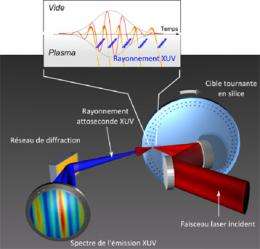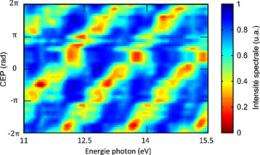Generating first-ever controlled ultrafast radiation, using a plasma

To observe ultrarapid phenomena such as the motion of electrons within matter, researchers need sources capable of producing extremely fast and energetic light radiation. Although devices capable of emitting pulses with attosecond (10-18 seconds) precision already exist, many research teams are striving to stretch the boundaries of these pulses' duration and intensity.
A French team headed by the Laboratoire d'Optique Appliquee, in collaboration with the CEA and the Laboratoire pour l'Utilisation des Lasers Intenses, has succeeded for the first time in accelerating and guiding electrons in a plasma in a reproducible manner, using a laser. These electrons excite the plasma, which then emits ultrafast electromagnetic pulses at wavelengths in the extreme ultraviolet. This high energy attosecond radiation could be used to study ultrarapid electronic processes. This work is published in Nature Physics.
Some events, such as the ionization of an atom or an electron jumping from one excited state to another, occur over typical time scales of the order of an attosecond (a billionth of a billionth of a second). To observe such events directly, light pulses of comparable duration need to be produced in order to acquire a “snapshot” of the evolution of the phenomenon, somewhat like a camera shutter. Until now, there was only one way to obtain such fast pulses, by exciting the electrons of a gas by laser. These electrons then emit a pulse in the extreme ultraviolet (X-UV) domain. However, this method has limitations and, in order to observe certain phenomena, researchers need sources that are even faster and, above all, which have higher energy. This has prompted numerous research teams to study the physics of plasmas, an extremely hot and dense state of matter constituted of ions and electrons.

The team headed by the LOA is the first to have obtained attosecond pulses in the X-UV in a reproducible manner by controlling the excitation of a plasma by electrons accelerated in a laser field. To achieve this feat, the researchers first developed a very efficient laser source, making it possible to obtain illuminations one thousand to ten thousand times those used in gaseous media, and delivering a thousand pulses per second, each lasting around several femtoseconds (10-15 seconds). In addition, this source is phase-stabilized: all the pulses generated are identical. The researchers succeeded in focusing the full luminous intensity of the laser on a spot a little larger than a micron in diameter, on the surface of a silica target. The target matter is thus transformed into a plasma whose density is comparable to that of a solid. The electrons in this plasma are strongly accelerated by the electromagnetic field produced by the laser beam. When they pass through the plasma, they excite a collective motion of charges inside it, thus producing X-UV radiation, which the researchers were able to observe and analyze using a spectrometer.
This work should lead to a high-energy radiation source that physicists and chemists could use to probe electronic processes in matter with attosecond temporal resolution. The research team is now planning to improve its laser source in order to generate even faster radiation at shorter wavelengths (in the X-ray domain). This should be achieved by controlling the motion of electrons, which move at velocities close to the speed of light, in the plasma.
More information: Attosecond control of collective electron motion in plasmas. Antonin Borot, et al, Nature Physics, On line on the 26 March 2012. Paper published in May 2012.
Journal information: Nature Physics
Provided by CNRS




















